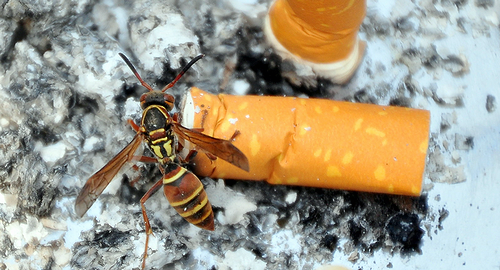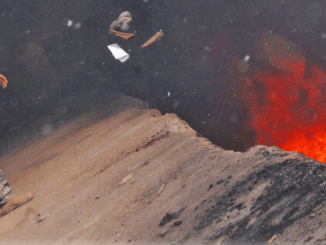
GOTHENBURG, Sweden, May 18, 2023 (ENS) – On the trail, in the gutter, at the bus stop, in the park, on the beach, cigarette butts are everywhere. In fact, cigarette filters are the world’s most common form of litter, and now University of Gothenburg researchers are calling for these filters to be completely banned.
The U. Gothenburg research group has shown that the microfibers and the chemicals that leak out of the filters in cigarette butts are toxic to aquatic larvae, the active immature form of some important insect families, such as dragonflies, mosquitoes, and stoneflies.
“The filter is full of thousands of toxic chemicals and microplastic fibres, so it’s not just any piece of plastic that’s being discarded into the environment. It’s hazardous waste,” Dr. Bethanie Carney Almroth, professor of ecotoxicology and zoophysiology at the University of Gothenburg, said.
The researchers say cigarette filters can contain as many as 7,000 chemicals as well as microplastic fibres.
They tested on aquatic mosquito larvae the effects of the toxins found in the filter after smoking, as well as the substances that are in the filter from the start.
It turns out that the toxins lead to a 20 percent higher mortality rate among mosquito larvae. Previous research has shown that the toxins in the filters also have adverse effects on many other aquatic organisms, too.
Fish, for instance, can die if they are exposed to concentrations corresponding to the toxins emitted by two cigarette butts in one liter of water for four days.

“Cigarette filters are also a major source of the microplastics that find their way into our environment – something we know has a major negative impact on biological life. The EU has already classified cigarette filters as hazardous waste,” Professor Almroth explains.
Leachate from a single butt can contaminate 1000 litres of water with concentrations of nicotine above the EU-predicted no effect concentration of only 2.4 × 10−3 mg L−1, so it qualifies as hazardous waste according to EU thresholds.
The study, “Time to kick the butt of the most common litter item in the world: Ban cigarette filters,” is published in the journal “Microplastics and Nanoplastics,” and in the March issue of “Science of the Total Environment.”
Trillions of Butts Tossed Every Year
The World Health Organization says 4.5 trillion cigarette butts are discarded worldwide each and every year.
The butts show up on beaches worldwide, including Florida, where Maggie Winchester, the Ocean Conservancy’s Florida Program specialist, works to conserve the environment.
“Walking along a breezy Florida beach is a wonderful feeling, the soft sand and gentle ocean waves enjoyed by locals and tourists alike,” Winchester writes on the Ocean Conservancy’s website. “Unfortunately, trash on our beaches is causing major threats to this idyllic image. Specifically, cigarette butts, the small fibrous filters at the end of cigarettes, are the most littered item found on beaches around the world.”
“During Ocean Conservancy’s annual International Coastal Cleanup in 2021, over 78,000 cigarette butts were removed from coastal areas in Florida alone, with over 1.2 million cigarette butts removed globally.”
“While these numbers may be shocking, many people do not realize the impact a single cigarette can have; in fact, a 2012 study even showed that 75% of smokers in the U.S. have thrown their cigarette butts on the ground in public at some point or another,” Winchester writes.
Winchester says the idea that cigarette butts break down harmlessly into the environment is a “misconception.”
“Cigarette filters are basically tiny webs of plastic that absorb the toxic chemicals of tobacco. When cigarette butts are left in the environment, the sun, rain and wind will ultimately break the plastic filter down into tiny microplastics, releasing the same toxic chemicals onto our beaches and into our waterways. These toxic chemicals, including nicotine, heavy metals and even carcinogens, contaminate soil, plants and water quality. To make matters worse, microplastics are often consumed by wildlife, blocking the digestive system and causing malnourishment or even starvation,” Winchester explains.
Who Cleans Up The Mess?
Under new environmental regulations in Spain, tobacco companies must pay the bill for disposing of cigarette butts by the millions that smokers discard every year.
The ruling, which took effect in January, conforms to a European Union directive limiting the use of single-use plastics and requiring polluters to clean up their messes.
But it’s not enough to just put out more ashtrays, the U. of Gothenburg researchers point out. They observed during their study how smokers in Gothenburg behave when it’s time to put out their cigarettes. They learned that many people throw their cigarette butts on the ground even if there are ashtrays nearby.

Professor Almroth said, “The clean-up costs the municipalities millions of kronor, but there will still be many cigarette butts in the environment. We are now conducting a survey of plastic litter across all of Sweden with the aid of community science in what we’re calling the Plastics Experiment. That way, we can work with school children and others to get better figures on where and how many cigarette butts with filters are found in the environment, in addition to other problematic plastic products.”
Her research deals with the effects of pollution in aquatic environments, with a focus on microplastic particles, chemicals and their effects in fish. But the problems with plastic in the oceans begin on land, Almroth understands.
She believes that filters don’t protect smokers and should not remain a component of cigarettes. Along with other experts, Almroth has written an opinion piece in the magazine “Science of the Total Environment” maintaining that cigarette filters are not just the most common litter item in the world, they are also just a marketing ploy that do little to protect the smoker, as many people believe they do.
“That’s why they have to be taken off the market entirely,” Almroth says. “It’s not the right approach to focus on making tobacco producers pay for cleaning up the filters. The problem should be prevented in the first place, rather than cleaned up later.”
Professor Almroth is also the responsible researcher for ForskarFredag’s mass experiment Plastexperimet, where school students and the public can help researchers increase knowledge about how much plastic is found in nature in Sweden, where it is found and what type of plastic it is.
“I want to get away from the view that it is the individual who litters that is the problem. The problem is systematic and exists at all levels in society,” she says.
The Plastic Experiment is divided into two parts – collection and analysis. During the collection part, participants will help to survey plastic litter in the Swedish environment. Each group of participants will select one of six types of natural environment and collect the plastic litter found in a 100-meter-long area. The collected litter is then weighed and sorted into different categories of plastic – disposable cutlery, straws and plastic bags. The data is then submitted using an online tool.
The Plastic Experiment, or Plastexperimet, is based on the Danish mass experiment Plastic pollution, which in 2019 engaged 57,000 students across Denmark, and resulted in scientific articles published in the journals “Nature” and “ScienceDirect.”
The Plastic Experiment is organized by the University of Gothenburg, the association Vetenskap & Allmänhet, the science festival ForskarFredag and the organization Keep Sweden Clean. The plastic experiment receives funding from the EU’s research and innovation program Horizon Europe.
Awareness of the danger of cigarette butts is spreading. On April 23, climate activists gathered 650,000 cigarette butts and heaped them up in Portugal’s capital Lisbon to raise public awareness.
German climate campaigner and biologist Andreas Noe, known as The Trash Traveler, said the group asked “everyone in Portugal” to take part in this community project to raise awareness about plastic pollution, because “plastic is hidden in cigarette butts and many people don’t know it.”
Featured image: A pot of dirt used as an ash tray near Rådmansgatan, October 13, 2007, Stockholm, Sweden. (Photo by Let Ideas Compete)
© 2023, Environment News Service. All rights reserved. Content may be quoted only with proper attribution and a direct link to the original article. Full reproduction is prohibited.


